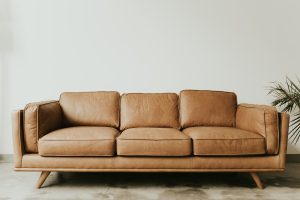
Understanding the relationship between fleas and leather furniture is pivotal to maintaining a pest-free home environment. Whether you’re a new leather furniture owner or you’ve been battling a flea infestation, this article dives deep into how fleas interact with leather surfaces, the effective treatments to rid them, and preventative measures to take.
Can Fleas Thrive on Leather Furniture?
Contrary to common belief, leather furniture is not an inviting habitat for adult fleas. Adult fleas prefer staying close to their animal host rather than being out in the open. While it may seem like they’re inhabiting your leather sofa or chair, in reality, they are more likely to be hiding in the crevices and cracks of the furniture or the carpet beneath it.
Leather may host flea larvae and eggs, which could potentially develop into adult fleas. These usually settle in the deeper, less accessible parts of the furniture, such as the seams or underneath the cushions. Thus, while your leather furniture might not sustain an adult flea population, it can serve as a breeding ground for larvae and eggs.

Factors That Influence Flea Infestation on Leather Furniture
Pet Traffic
If you have pets that frequently lie on your leather furniture, you’re providing a direct pathway for fleas to transfer from your pets to the furniture. These fleas might not last long, but their eggs can.
Environmental Conditions
Humidity and temperature also play a significant role. Fleas thrive in warm, humid conditions. The less hospitable the environment, the less likely you’ll face an infestation.
Natural Ways to Kill Fleas on Furniture
Vinegar-Based Flea Sprays
A vinegar-based flea spray can be effective and eco-friendly. Mix equal parts of apple cider vinegar and water, and spray it liberally on the furniture. Fleas detest the smell and taste of vinegar, making it a natural deterrent.
Essential Oils
Certain essential oils like lavender, cedarwood, and lemongrass can effectively repel fleas. However, use them cautiously, especially if you have pets or young children, as some oils can be toxic if ingested.
Chemical Treatments for Flea Infestation on Leather
Insect Growth Regulators (IGRs)
These are synthetic hormones that interfere with the life cycle of fleas at the larvae stage. They are long-lasting and can be highly effective.
Adulticides
These are specifically designed to kill adult fleas and are generally used in combination with IGRs for a more comprehensive treatment.
Post-Treatment Measures
Once you’ve used chemical treatments, ensure that the furniture is completely dry and thoroughly vacuumed before using it again.
Precautionary Steps to Prevent Fleas on Leather Furniture
Regular Vacuuming
Regular vacuuming is crucial to suck up adult fleas, eggs, and larvae. Focus on the crevices, seams, and underneath the furniture for best results.
Wash Pet Bedding
Frequently wash your pet’s bedding in hot water to eliminate any possibility of flea growth.
Diatomaceous Earth
This natural mineral powder can be sprinkled on your furniture. It’s harmless to humans and pets but dehydrates fleas, effectively killing them.
FAQs: Fleas and Leather Furniture
How Long Can Fleas Live on Leather Furniture?
Fleas can survive on furniture for approximately 5-14 days, while their eggs may last a few months.
Can Lysol Kill Fleas on Leather Furniture?
Yes, Lysol can effectively kill fleas if sprayed directly onto them. However, it’s not an effective long-term solution.
Do Essential Oils Help in Keeping Fleas Away?
Yes, oils like lemongrass and mint can deter fleas due to their strong aroma.
We hope this comprehensive guide helps you understand the dynamics between fleas and leather furniture and equips you with the tools to maintain a flea-free living environment.









